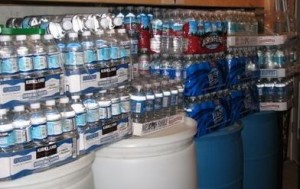 Storing water can take up a lot of space. If you don’t have much room extra room in your home, you might want to check out my other post, The Easiest Way to Purify Water. But if you have enough room and don’t want to worry about hauling water back and forth from a pond, here’s what you need to know.
Storing water can take up a lot of space. If you don’t have much room extra room in your home, you might want to check out my other post, The Easiest Way to Purify Water. But if you have enough room and don’t want to worry about hauling water back and forth from a pond, here’s what you need to know.- Water is the nectar of life. Other than oxygen, nothing is more important to your survival. The body uses water for digestion, transporting nutrients, building tissue, removing waste, and regulating body temperature, among other things. Without water, you would only last a few days.
- Don’t count on tap water. If a disaster happens, most water treatment plant employees will not show up to work. And if the power is out, they wouldn’t be able to run the plant anyway. But even if there is power and they make it to work, they might not be able to get the supplies they need due to truck drivers who can’t get into town.
- Store 2 gallons of water per person PER DAY. Although technically you only need to drink a half gallon a day, you might find yourself perspiring more than usual while gathering supplies, clearing debris, etc. People in this situation might need to drink as much as a gallon a day. The other gallon is for cooking and bathing. Also, don’t forget to store at least a quart of water per day for pets (half a gallon for larger dogs).
- Store at least 4 weeks of water. That’s the bare minimum. If you have infants, elderly, or sick people in your home, 8 weeks is the bare minimum.
- Use thick storage containers. Ordinary plastic containers are too thin and leak or break after only a few months. Instead, find some official water storage containers
.
- Keep it cool. Your water should be kept in a cool, dry place away from direct sunlight or heat sources.
- Rotate every year. You should write down the date when you put water into storage so you know how old it is. After 10 or 11 months, start drinking and replacing it.A few warnings:
- Do not use empty milk jugs or any other container that was used for another liquid. No matter how well you clean them, you won’t be able to remove bacteria and chemicals that have become lodged in the plastic.
- Do not store your water near gasoline, pesticides or toxic substances. Even good containers are slightly porous and it’s possible for fumes to eventually make their way inside to the water.
- Water is heavy—about 8 pounds per gallon—so be sure to keep it somewhere with adequate support. Garage floors and basements are ideal.
- Do not drink pool water. I’m sure there are many people with pools who aren’t bothering with water storage, but this is a huge mistake. Although chlorinated, pool water contains many chemicals that are unsafe to drink.
Other thoughts:
- Buy collapsible containers. 5-gallon collapsible containers can be found for around 10 bucks at most sporting goods stores. In case a disaster happens and you don’t have any water, you might have time to fill these containers with tap water before the water supply is contaminated or the pressure is gone.
- Use chlorine bleach. This is for those who didn’t purchase distilled water. You can make regular water last a lot longer by putting 4 or 5 drops of bleach in every gallon. After doing so, wait 30 minutes and see if you can smell the chlorine. If you can’t, add some more.
- Pour your water. If your storage water tastes stale, try pouring it back and forth from one container to another several times. This gets oxygen back into the water and improves the taste.
Source:http://urbansurvivalsite.com

